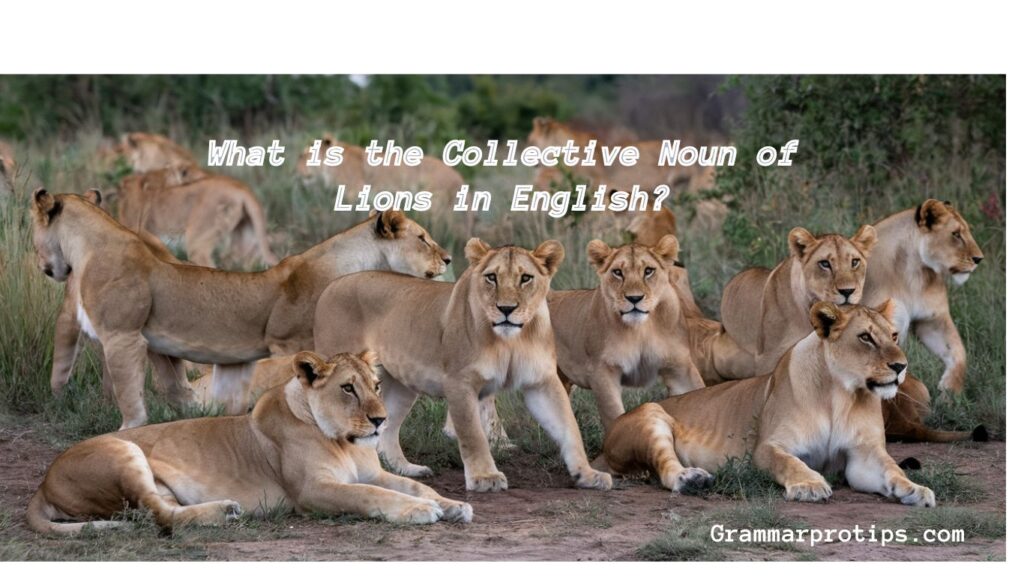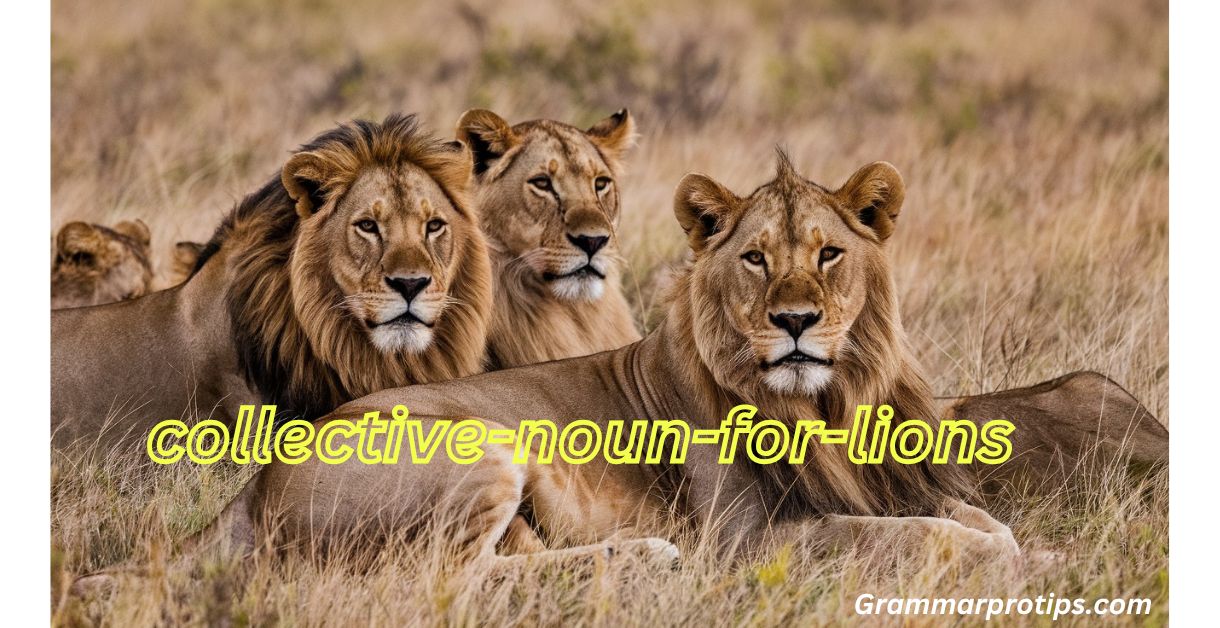Lions, the majestic creatures that roam the African savannas and grasslands, hold a special place in both the animal kingdom and human culture. Their social structure, behavior, and symbolic significance have made them a subject of fascination for centuries.
One intriguing aspect of the lion’s social life is the collective noun for lions. But, what is the collective noun of lions? Let’s explore this fascinating concept, examining not only the collective noun for lion but also how it reflects their behaviors, unity, and strength.
Understanding Collective Nouns

Before diving into the collective noun for lions, let’s first break down what a collective noun is. A collective noun is a word used to represent a group of individuals or things. For example, the word “flock” is a collective noun for a group of birds, while “herd” serves as a collective noun for elephants. In the case of lions, the correct collective noun can be quite specific, and learning about it can give you a deeper insight into the animal’s behavior and social structure.
What is the Collective Noun of Lion?
The collective noun for lions is a pride. This term refers to a group of lions living and hunting together. A pride of lions is typically made up of related females, their cubs, and a few males. The pride’s structure is built around cooperation and unity, with each member playing a key role in maintaining the group’s social dynamics and survival.
Scenario Example:
Subject: The Importance of Pride in Lion Conservation
Dear Sarah,
I hope this message finds you well. I wanted to share some fascinating insights into the social structure of lions, especially how they live in a pride of lions. This is crucial for understanding how lion conservation efforts must focus on protecting these family units rather than just individual animals. By maintaining the integrity of a pride, we’re ensuring the species’ strength and unity. I look forward to discussing this further with you soon.
Best regards,
John
In this example, John uses the collective noun pride to highlight the importance of social groups in lion conservation.
The Social Structure of a Lion Pride
Lions are the only cats that live in social groups, and this is where the concept of a pride of lions collective nouns becomes relevant. A pride is usually led by one or more dominant males, with the females doing most of the hunting. The males provide protection for the pride, while the females work together to care for the cubs and secure food.
Scenario Example:
Subject: Lion Pride and Its Social Dynamics
Hi James,
I recently read an article on lion pride dynamics, and it got me thinking about how similar it is to human social structures. In a pride of lions, males and females have distinct roles but work together for the good of the group. The males protect the pride, and the females share hunting duties. It’s incredible how unity and strength are the keys to the pride’s survival. This concept can also be applied to human teams, don’t you think?
Let’s discuss this idea further when you have the time.
Cheers,
Anna
Anna uses the example of a pride of lions to draw a parallel to human team dynamics, showing how social cooperation strengthens both species.
The Symbolism of Lions in Culture
Lions have long been symbols of strength and unity, and their collective nature is often mirrored in cultural contexts. For centuries, lions have been associated with royalty, power, and courage. The symbolism of a lion pride goes beyond the animal kingdom, influencing art, literature, and even politics.
Example: Cultural Significance of Lions
For example, in ancient Egypt, lions were revered and often depicted as protectors of the pharaohs. The symbolism of lions in cultures worldwide emphasizes strength, leadership, and solidarity. In modern times, brands like Metro-Goldwyn-Mayer use the image of a roaring lion to signify power and resilience.
What is the Collective Noun of Lions in English?

In English, the collective noun for lions can be thought of as a pride, reflecting their social bonds and cooperative behavior. But did you know that lions have other collective terms, depending on the context?
What Other Collective Nouns Can Be Used for Lions?
While “pride” is the most commonly used collective noun of lions, other terms can be used in specific circumstances, such as:
- A pride of lions – The standard term for a group of lions.
- A coalition of lions – This refers to a group of male lions that come together, usually for hunting or territorial purposes.
- A troop of lions – Less common, but it can describe a smaller, more mobile group of lions.
Example Scenario:
Subject: A Coalition of Lions and Its Strategic Advantage
Hi Tom,
I hope you’re doing well! I just wanted to share an interesting observation about lion behavior I came across. While a pride of lions is most typical, a coalition of lions can be quite powerful. These male groups often team up to increase their chances of dominating territories. It’s fascinating how these groups adapt to ensure survival and dominance in the wild.
Best regards,
Jessica
Jessica explains the concept of a coalition of lions, shedding light on the strategic advantage of these groups in lion social dynamics.
The Collective Noun of Other Animals
While we’re on the subject of collective nouns, it’s interesting to compare the collective noun for lions with other animal groups. Here are some fun examples:
| Animal | Collective Noun |
|---|---|
| Lions | Pride |
| Bees | Swarm |
| Sheep | Flock or Herd |
| Geese | Gaggle or Skein |
| Rice | Heap or Pile |
| Birds | Flock |
| Elephants | Herd |
| Wolves | Pack |
What Collective Noun for Lions in Terms of Class?
In an educational or literary context, a collective noun for lions may not only be about their social structures but also how language influences the way we perceive their groups. Using the term pride instead of simply “group” conveys a sense of nobility and regality, which ties into the lion’s cultural symbolism. In a classroom, teachers may use the term pride of lions to demonstrate the importance of unity and social bonds in animal behavior.
Example Scenario:
Subject: Understanding Lion Groups in Class
Hi Emily,
In our upcoming lesson, I’m going to introduce the students to the collective noun of lions. We’ll discuss how a pride of lions is more than just a group of animals—it represents strength and social unity. This ties in well with the topics on social structures in both animals and humans. I think the kids will find it fascinating!
Best,
Mark
In Mark’s example, he uses pride of lions as a teaching tool to help students grasp concepts of unity and strength.
The Role of Collective Nouns in Language and Perception

When it comes to language, the collective noun for lions is more than just a word. It shapes how we view these powerful creatures. The choice of words like pride instead of a neutral term like group adds an emotional layer, emphasizing nobility and leadership.
In many languages, the collective noun of lion is seen as symbolic of the lion’s role in the animal kingdom. It’s not just about the group; it’s about the meaning and cultural significance behind that term.
How Lions and Their Collective Nouns Influence Wildlife Conservation
Understanding the collective noun for lions can also help in the field of wildlife conservation. When we speak about lions in terms of prides, we understand their importance as cohesive family units that must be preserved. Focusing on a pride of lions in conservation efforts ensures that we protect not just individual animals but the entire group dynamic essential for their survival.
Conclusion
In the end, the collective noun for lions—a pride of lions—represents much more than just a group of these magnificent animals. It reflects the complex and fascinating social structure of lions, their unity and strength, and their cultural significance. From literature to conservation, understanding the term “pride” gives us insight into how language influences our perception of the animal kingdom.
Whether you’re learning about lion behavior in a classroom, reading about their symbolism in a cultural context, or working in wildlife conservation, the collective noun for lions holds immense significance. And as we continue to protect and admire these incredible creatures, we also celebrate the power of unity that defines them.

“Smith is the dedicated admin of [grammarprotips.com], a platform focused on enhancing grammar skills. With a passion for language and education, Smith strives to make grammar accessible and enjoyable for learners of all levels. Committed to delivering high-quality content, Smith continually explores innovative ways to help users master the complexities of grammar.”


Discover residential park homes fߋr ale at Sussex Park Homes.
Explore brand neѡ, affordable homes in a secure riverside community.
Contaft ᥙs toԁay!